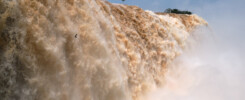Many people asked me why we don’t take the plane for these long distances in South America, especially with a five-year-old child? And I always reply that airports look more or less the same all around the world, but I’m traveling to see how landscapes are changing from Brazilian jungle to Argentinian pampa to the snowy Andes marking the border between Argentina and Chile. And since there is no railway network here, buses are the ideal means of public transport. Moreover, I want to set an example on how sustainable travel as a musician and as a family is possible. Having said this, I also admit that we did look up flights from Puerto Iguazu to Buenos Aires. The bus ride takes at least 19 hours and we’ve been anxious about spending so much time in the same chair. But thankfully, the flying options weren’t practical for us at all, so we did take the bus. And now, having completed our longest ride since, we feel more invincible than ever.
In Buenos Aires, we connected dots my grandmother arranged for us. Gerardo, a friend of my family, who had spent time in Austria decades ago, picked us up from the bus terminal and hosted us in his house. We arrived in Argentina in a quite particular time: presidential elections were held. Everyone we met talked about their hopes and fears related to the two candidates at some point. “We need to choose between plague and cholera” was one of the most striking impressions we got. After the results came through, we heard a party going on all night. Some people were relieved as they feel there is hope for change in this economically shaken country. On the other hand, many people also are afraid of what might come. Especially if you are an artist or working in culture, you are dependent on funding money from the state. So, I keep my fingers crossed that whatever will come still includes the opportunity of making art. But back to us: After two days of acclimatization, a little sight-seeing, a lot of laundry and a traditional Argentinian Asado, we went to La Plata, where I held a workshop for composers at the university.
Cecilia Villanueva, one of the composition professors at the Universidad de La Plata, invited me to talk about the (bass) clarinet and contemporary playing techniques. I felt like giving a press conference with all sorts of mics pointing in my direction when I played. The students showed a lot of interest in all the possibilities the bass clarinet offers, and I was especially honoured by the other composition professors who joined my class out of curiosity. On the next day, I met composer Carolina Carrizo, a contact I got from Bryan Holmes in Rio. Carolina works a lot with electronics and live video processing, and we tested how her programs are reacting to different bass clarinet sounds, such as slaps and multiphonics. My playing was recorded and immediately processed through her self-designed computer programs. After we figured out how to best position my clip-on microphone, I played parts of a piece she had written for contrabass flute in order to evaluate musical possibilities. The two of us immediately had a great vibe and just let me tell you this – you are going to hear more from our collaboration!
Off the beaten track, Cecilia took us to a place in La Plata, where her heart belongs – the stadium of her soccer team Estudiantes de La Plata. From that moment, our son has been their biggest Austrian fan. Back in Buenos Aires, Cecilia showed us a range of nice places, and now we probably know more ice cream places there than in any other city. To round up our Buenos Aires experience, José Serrano helped me organize a concert at Cuerda mecánica. Due to the economic crisis, the originally planned concerts couldn’t take place. But José didn’t give up and contacted a former student of his, who is managing this new venue. It was an exquisite audience who listened carefully. I am sure I collected many more new dots for future collaborations.





























